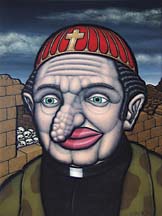 SLOWINSKI, Catholic Priest in Iraq, 24" x
18", acrylic on canvas
SLOWINSKI, Catholic Priest in Iraq, 24" x
18", acrylic on canvasCurrent Issue Highlights More Readings DA Home About Direct Art
EAST VILLAGE SOP STORY
by Tim Slowinski
 SLOWINSKI, Catholic Priest in Iraq, 24" x
18", acrylic on canvas
SLOWINSKI, Catholic Priest in Iraq, 24" x
18", acrylic on canvas
I did not bother to see the New Museum show, but I read about it and saw the list of artists included. The big feature was Haring and Basquiat, but aside from hanging out in clubs and snorting heroin they did not have that much to do with the place. They abandoned it and jumped over to Soho the first chance they could get—along with everyone else in the end. The village was full of losers and burnouts, the galleries that made something out of themselves weren’t indigenous but were mostly opportunistic ivy league implants who jumped on the bandwagon to score some notoriety. It didn’t have much to do with art really, New York doesn’t, it’s all about glamour, ego and cash.
After doing a few shows at clubs and galleries I opened my own place on 10th Street in 1987, by then the scene was winding down. There were still a lot of galleries there, but many had closed, succumbed to the falling stock market, to drug addiction or aids. The store I rented was formerly a gallery run by a guy who died of AIDS. There was a lot of abandoned art in the place when I got it, real garbage, masking tape stuck on stretcher bars and spray painted, junk from the street that was stuck to the wall. That was the thing, there were so many junk bond millionaires driving around the neighborhood throwing away money that anybody could stick a piece of crap on the wall and have shot at making a few thousand off it.
Of course selling is one thing, getting written up in the NY Times and Art in America was something else altogether. It did not matter how much art you sold. I sold tons of paintings to collectors all over the world, but the only way I’d get a critic into my store would be to shoot one and drag him in dead. It’s like Kostabi said, it’s all about the finger and the only thing I had mine in was a piece of tofu in the back of my store. There was a well connected artist up the block from me who had a small gallery. They wrote about him in the papers and magazines constantly, called his gallery "an important East Village gallery." He began showing other artists and eventually gave up doing his own art. Then he closed the New York gallery and moved to India. He set up shop in Bombay somewhere selling paintings to tourists. He was in the New Museum show, still an "important" East Village artist.
In the end the stories became a mythology that is much more appealing than the reality of the place. Basically is was a drug infested, garbage and dog shit strewn neighborhood full of abandoned stores that nobody wanted. The artists, forced into a position of desperation by an obstructive and uncultured society, moved into this lowest of lowlife locations and set up shop. Once they were there, the real estate and media interests worked in concert and played them like a Stradivarius. The bickering and posturing of the artists and wannabees maintained a sufficient distraction while the real winners in the scenario, the landlords, improved their position. Soon abandoned storefronts that rented as 50 dollar a month Hispanic-drinking clubs were transformed into $8000 a month sushi shops and boutiques. The artists who made it all possible were shoved out to colonize other decrepit regions that were in turn transformed. Now Manhattan is a wrap and they have the artists working on Brooklyn and the Bronx.
The artwork, the exhibits, the articles and the controversy, is nothing but a shell game. Like ornaments on a tree, paintings decorate the neighborhood, hanging like a glistening lure. Mesmerized by the shimmering lights, the masses bring their money in bags and drop it at the feet of Mammon. Hopelessly, the artists stand by in wonderment and admiration.
Current Issue Highlights More Readings DA Home About Direct Art